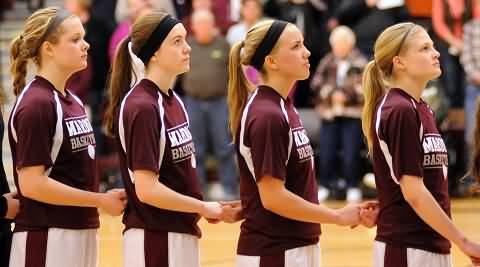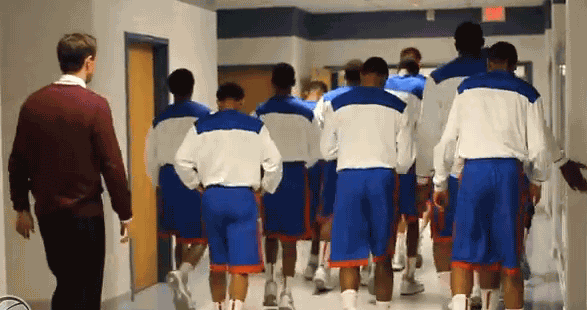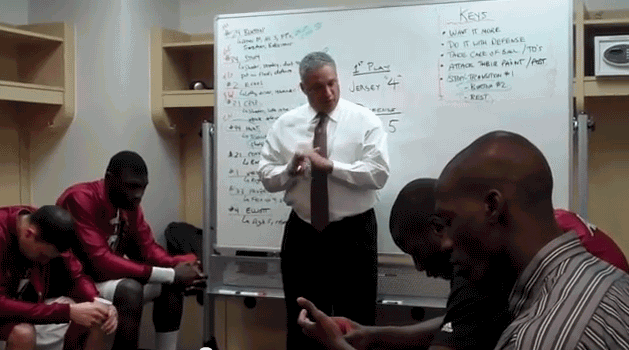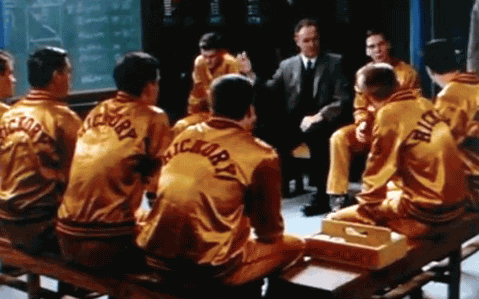Basketball Coaching - Pre-game Preparation
By Dr. James Gels, from the Coach’s Clipboard Basketball PlaybookDisclosure: This page contains affiliate links, which means that Coach's Clipboard receives a small commission (at no cost to you) if you make a purchase using these links.
I am referring to the immediate pre-game time, not the week of practice before the game. This is an important time for the players and coaches to get comfortable with the situation at hand, and focus on the job to be done. Being organized is very important, so that everything is a routine, with no surprises. Every coach has his/her own way to get the team ready.
It's a routine...
This is what seems to work for us (high school level). Your approach could be different and if you coach a youth or AAU team most likely will be more simple. But the key is to have a standard routine that you do every game, whether on the road or at home.
Look and act professional
Looking and feeling good, and acting appropriately, are important. Our high school varsity players and coaches all wear approved, classy-looking team attire. We also expect everyone to act with class. Parents, teachers and fans are proud to see their kids looking good in team attire.Allow enough time
Get to the gym early. Rushing around at the last minute creates a disorganized, frantic mood. You want players and coaches to be relaxed, calm and in control. Arrive at least 45 minutes before the game (or sooner if you have a home game and want to watch game film, or the JV game).Players need time to get dressed, get ankles taped, stretch, perform warm-up drills, and practice shooting and free throws. We allow about 10 minutes for the players to get dressed, while we organize the bench, get clipboards and stats sheets ready, make sure we have enough chairs/seats for our players, etc.
Then the coaches enter the locker room (all players are dressed and ready) and we have our pre-game meeting (about 10 minutes). Make sure you have a clipboard, marker pen and eraser. Then we take the floor. If there is a preceding game, our players will go to the locker room a few minutes into the second half, and the coaches will enter at the end of the third quarter.

Things to do before the game
There are routine tasks before each game. You can designate much of this to your assistants, giving you time to visit with the refs and opposing coaches.- Review with your assistants the starting lineup and defensive match-ups, substitution patterns, and any special strategies for this game. An assistant can write the names of the starters on the clipboard along with the number of the player they will be defending. He/she can inform the starters (while they are warming up) who they will be guarding, rather that just matching-up around the center-jump circle.
- Assistants should know their roles and where you like them to sit. One assistant keeps track of player fouls, time-outs, opponent's individual fouls, etc. Another assistant may help in looking at X's and O's, offenses and defenses, press offense and press defense, opponent's strengths and weaknesses, etc.
- Enter your roster in the official scorebook in advance.
- An assistant makes sure there are enough chairs for everyone on your bench.
- Have your clipboard ready, with extra marker pens and a cloth/eraser.
- Make sure your medical kit is available.
- An assistant gets the stats forms ready for your statisticians - on clipboards with sharpened pencils (or an electronic tablet).
- Have your manager collect, fold and stack the warm-ups. Make sure each player and coach has a water bottle.
- If you are in a strange gym with ambiguous lines, before they get dressed, walk players around the floor showing them the out-of-bounds lines, etc. Lines are not always obvious in a gym used for volleyball or other sports.
- If it is an AAU competition, have all your player's ID cards and birth certificates ready in an envelope.
- For AAU and youth, learn in advance of any special rules such as running clock, number of time-outs, etc.
- Stretching... players can do stretching exercises in the locker-room or hallway, before taking the floor.
The team meeting (before taking the floor
This meeting is used to focus our players on the job at hand, discuss our game plan, and review the things that help make us successful. We might start with a story, something that happened to one of us, something that might make us laugh, or cry, but will bring us together for having shared it. Sharing a private story can strengthen togetherness.
We announce the starting line-up and then review our defenses, half-court and full-court, and any special adjustments that we have worked on in practice specifically for this opponent. We point out the opponent's best players and how we plan to contain them.
We discuss our half-court offense vs man-to-man and zone defenses and any special plays, out-of-bound plays, etc. We might remind the players about maintaining good spacing, to move without the ball, set screens, and the importance of offensive rebounding. We might mention keeping under control, and avoiding turnovers.
We will discuss how we want the game to flow... the tempo. We remind everyone to box-out, rebound and play hard on defense. We stress three attitudes on defense: contest every shot, protect (deny) the paint area, and one-shot only mentality... no opponent offensive rebounds, no second and third shots.
Then hands together in the huddle, we yell a cheer and are ready to go.
A word about starting line-ups
At the high school level, it's often the same starters, but we might want to make a line-up change here or there.If you are coaching a youth team, don't make a big deal out of who is starting. Let all of your players take a turn at starting, as I think this creates better team chemistry.
I tell players that "it's not who starts, but who can finish the game".
Motivation and the "big" game
Sometimes coaches want to come up with a great, passionate "win one for the Gipper" speech or an inspirational quote to get the team fired-up. Players already know that it's a big game and may be over-hyped and nervous.Instead, try a calm, business-like approach. It's how you prepare in practice, and how you work on fundamentals, team skills, etc that really counts. We try to maintain a business-like attitude with our high school players... everyone has to do his/her job every practice and during every game.
Advise nervous players not to worry about playing good or playing bad, winning or losing... just do your job like always... nothing more, nothing less. This seems to help. Being nervous is normal. Channel nervous energy into playing great defense, rebounding and hustling for loose balls.
We use this job-like mentality in helping counteract outside influences too... like breaking up with a boyfriend (girlfriend), or failing an exam on the day of the big game. As adults, we might have a personal problem, but we still have to go to work that day and do our job, regardless.
Same way with players... no matter how bad your day has gone, when you step on the court, "do your job", don't let your buddy down. Enjoy the moment and have fun. For most players their basketball career is really short. It goes by fast. So they should enjoy this time with their teammates.

Players on the floor
After the locker-room meeting, players take the floor, start stretching and doing their warm-ups. Whatever pre-game drills you do, make sure that you get them moving and hustling, so they work up a little sweat and are ready to play. If your team habitually gets off to a slow start in the first few minutes, review your pre-game drills and make sure players are not loafing. Warm-ups are for getting ready to play.Make sure to get in enough free-lance shooting. Players should shoot the shots they are likely to get in the game. If time permits, shoot team free throws.
See: Pre-game Warm-up Drills